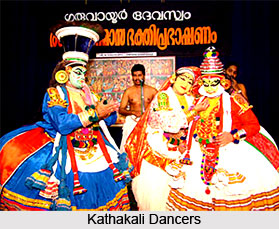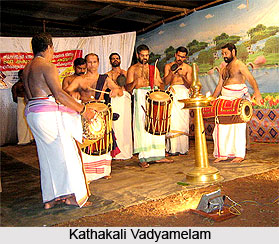 Repertoire in Kathakali borrows heavily from both Mahabharata and Ramayana. Kathakali is generally performed in the evening. It begins with the beating of drums as that plays a key role in creating an atmosphere to perform. The play is performed outside with the light of a single oil-lamp. The beating of drums is done to get the attention of the audience. Dance is combined with dialogue to bring about a life in the myth and legends narrated. In the actual performance, there are three main types of characters: the Satvik which include gods, kings or heroes; the Rajasik, characters with specific vices, such as greed, lust, or vanity; and the Tamasik, the evil characters, such as demons. The basic moral is always the eternal warfare between good and evil.
Repertoire in Kathakali borrows heavily from both Mahabharata and Ramayana. Kathakali is generally performed in the evening. It begins with the beating of drums as that plays a key role in creating an atmosphere to perform. The play is performed outside with the light of a single oil-lamp. The beating of drums is done to get the attention of the audience. Dance is combined with dialogue to bring about a life in the myth and legends narrated. In the actual performance, there are three main types of characters: the Satvik which include gods, kings or heroes; the Rajasik, characters with specific vices, such as greed, lust, or vanity; and the Tamasik, the evil characters, such as demons. The basic moral is always the eternal warfare between good and evil.
The playing of the drums or commonly called melappadam is followed by a devotional song called the todayam. Here one or two characters invoke blessings of God. Todayam is performed behind a curtain held by two stage-hands. After that a piece is performed known as the purappadu. Here two characters appear, it is either the hero and his consort, or two other characters who are painted green, or even the Pandavas. The purappadu is a dance of invocation which has no mime. Several dance sequences are performed known as kalasams. Through these cadences the techniques of Kathakali are performed. After this, the play that is chosen for that evening starts.
 There is the slow revelation of the character from behind the curtain before any major character appears. As the curtain gets lowered the character gradually appears. A powerful character when appearing for the first time stands close behind the curtain. The character executes many dance sequences which is accompanied by drums and cymbals and seen by the audience partially. The suspense is maintained. Then the curtain disappears and he appears in his full beauty. The play with curtain is commonly known as tiranokku.
There is the slow revelation of the character from behind the curtain before any major character appears. As the curtain gets lowered the character gradually appears. A powerful character when appearing for the first time stands close behind the curtain. The character executes many dance sequences which is accompanied by drums and cymbals and seen by the audience partially. The suspense is maintained. Then the curtain disappears and he appears in his full beauty. The play with curtain is commonly known as tiranokku.
The story opens out through Nritta, Natya and Abhinaya. The Malayalam text is closely followed by the performers. Malayalam plays such as Nala Charitam, Bali Vijayam, Kalyana Sougandhikam, Sita Swayamvaram, and Lavanasuravadham were written specifically for singing in Kathakali. The passages contain soliloquies or are highly descriptive for the actor to present abhinaya. Sometimes, they do have key words which give the dancer full opportunity in presenting variations. Occasionally there are passages of court drama and dialogue on which dramatic climax is built up. The passages sung are combined with musical accompaniments. Consequently after a Padam has been sung and the abhinaya has been done, the singer stops singing. The actor then interprets the literary content through gestures with the accompaniment of the musical instruments. This is known as the manodharma which enables the actor to improvise. During the manodharma an actor can hold the audience over one sequence for hours.
Kathakali evoke a state, a Sthayi bhava and a rasa through a familiar story of the Indian Puranas. It has a familiar music, symbolic make-up, stylized costuming and headgear. Kathakali is apparently the only dance performance which follows the classical tradition of presenting a particular rasa as the content of a dramatic performance. Kathakali is a vital form of theatre which has its roots in classical tradition.
Kathakali continues to maintain a distinctive Indian character. The coming of the Arabs, the Dutch and the Portuguese seems to have influenced Kathakali. Despite this influence, its fundamental spirit continues to be Hindu in character. Kathakali continues to follow ancient aesthetic norms in presenting its basic objective to induce a state of being.



















